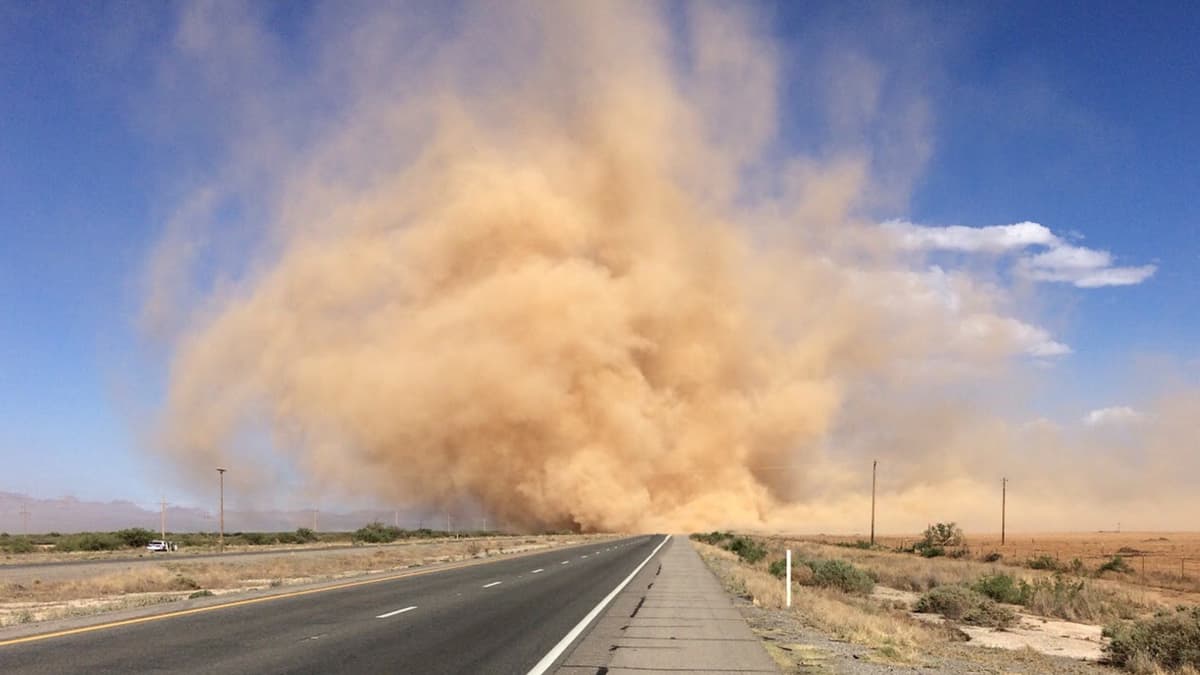Last month, FreightWaves asked professional truckers to rank some of the most dangerous weather conditions they face while on the job. Of the four choices, freezing rain/ice ranked No. 1. We wanted their feedback again, this time about dust storms, hailstorms and tornadoes. Based on a brief social media survey, here’s what they had to say.
Hailstorms
66.7% of the votes
Severe thunderstorms that produce large hail typically hit the Plains and Southeast in the spring. However, they can strike at other times of the year too — and in other regions of the country. By definition, the National Weather Service (NWS) considers hail “severe” if it’s at least 1 inch in diameter.
Large or not, hail that falls hard and fast can reduce visibility in a matter of seconds.
Another risk for drivers during hailstorms is body and windshield damage to the truck. If the hail is big enough, it can “punch” holes right through the windshield, and body damage repair may require a professional.
Also, many drivers suggest not using the jake brake during a hailstorm since the roads can be more slippery than they appear. More information on how to properly use a jake brake can be found here.
Tornadoes
33.3% of the votes
Another product of severe thunderstorms is tornadoes. Drivers should always have a reliable way of receiving NWS warnings no matter where they are.
The NWS has an excellent track record of predicting what regions may see tornadoes on a given day, but it’s impossible to know exactly which spots in those regions will get hit. If a tornado is spotted by someone on the ground, or radar indicates a likely tornado, the NWS will issue a warning. Once issued, the average lead time to seek shelter is about 13 minutes.
The best place to go is a basement, but this could be hard for drivers to find while on the road. Instead, if drivers receive a tornado warning, they should pull off an exit and get to the first floor of a sturdy building. Make sure it’s a space with very few or no windows and hunker down toward the middle of the room.
If a driver sees a tornado and can’t get to shelter quickly, stop on the shoulder, abandon the big rig and lie face down in a ditch off the side of the road with hands over head. This can help protect the driver from flying debris. Never try to outrun a tornado. They often move faster than they appear, and they can sometimes change direction.
Dust storms
No votes
Even though nobody voted for dust storms, ones that sweep across the Desert Southwest can be very threatening to professional truckers. Unfortunately, dust storms are sometimes hard to predict.
During an intense sandstorm or dust storm, called a haboob, sand and/or dust can be lifted as high as 5,000 feet high. This results in a wall of dust along the leading edge of the storm. Haboobs commonly cause a rapid and significant reduction in visibility as well as an increase in wind speed following the passage of the storm’s leading edge. These winds can last for a few hours in some cases.
The name “haboob” comes from the Arabic word “habb,” meaning “to blow.” The term originated as a description for sandstorms/dust storms in central and northern Sudan. However, the term is now commonly used to describe any wind-driven sandstorm or dust storm in arid or semi-arid regions around the world.
If drivers get caught in haboobs, they should pull over and wait it out. Bad ones usually result in road closures. They should keep their windows tightly closed and get some rest until the storm passes.
Click here for more FreightWaves articles by Nick Austin.
America’s best roads for truckers (weather permitting)
Truck drivers’ favorite weather movies of all time
3 kinds of weather perilous to driver health











USA Breakdown
From personal experience, I’ve driven in many types of weather. The one that stands out to me the most was a sand storm I went through on my way to southern California early in my career. I remember seeing it off in the distance and thinking “That looks absolutely crazy”.
Before I knew it, I entered that mess with a 10,000 lb load. I remember my co-driver waking up and strapping himself into the passenger seat as we were getting blown around. With so little weight in the box I was sure we’d run the risk of getting blown over. As fate would have it and to my surprise, after being knocked around for about 5 minutes we came upon a rest area.
With my inexperience I didn’t want to risk it so we pulled in there and waited about an hour or so for it to pass. Having to use the restroom in a sand storm is no fun by the way. It was just a short 30 foot trek to the bathroom and I don’t think we ever got all the sand out of the truck after that.
Surprised no one voted for that!